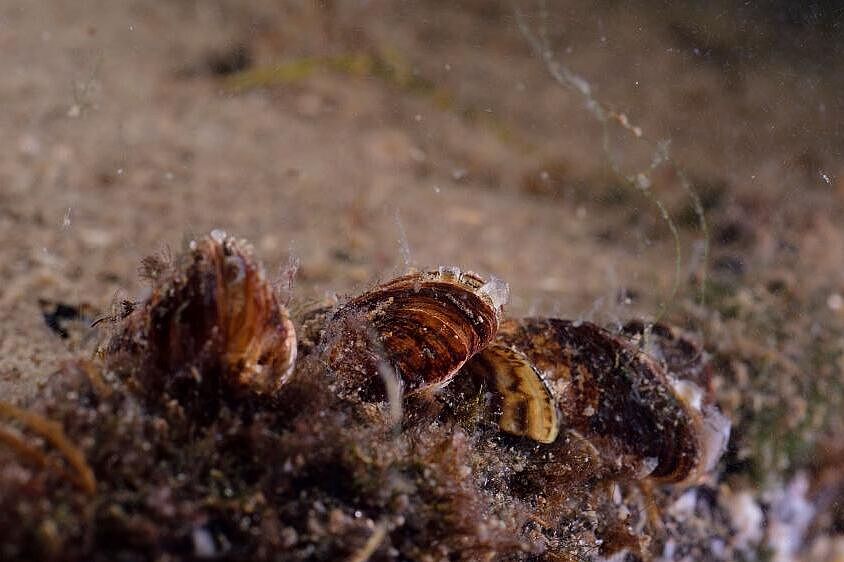We have all collected mussels from the shore, but do they also exist in freshwater ecosystems? Just how many of these inconspicuous mussels can be found beneath the surface of inland waters became apparent during the Oder River disaster in 2022, when tons of mussels perished. Empty mussel shells still line the banks of the Oder. Freshwater mussels are the industrious cleaners of lakes and rivers, filtering small algae out of the water and keeping it clear. This positive image has suffered since the spread of the invasive quagga mussel. The voracious appetite of this newly introduced species means that fish in Lake Constance and other water bodies are deprived of plankton as a source of food. Keeping them in check also costs a lot of money: masses of quagga mussels clog up pipes and boats. We put five questions to IGB researchers to find out more about these industrious filter feeders.
In 2022, vast numbers of mussels in the Oder River were killed by the toxin from the brackish water algae Prymnesium parvum. Dr Wolter, you primarily investigate the recovery of fish stocks in the river after the disaster through regular fishing, but also monitor mussels. What is the status of the stocks and the possibility of recovery?
Christian Wolter: Around 63 per cent of the mussels – of the Anodonta and Unio genera – were killed in the Oder disaster. Our spot checks after the major fish and mussel die-offs have shown that fish stocks are recovering faster than mussels and snails. We expected this because fish are much more mobile. In general, mussels have a hard time in our rivers: dredging and other water management practices have greatly reduced mussel populations in many running waters. For one thing, mussels are swept up with the dredged material. For another, hydraulic engineering generally results in increased sediment transport, which mussels do not tolerate very well. If, then, the Oder is developed further as a waterway, mussel populations will not recover. In fact, many river mussels are protected by the Federal Ordinance on the Protection of Species (BArtSchV), which means that their habitat should be protected as a matter of priority. However, this is often not the case. Mussels have no lobby.
Dr Wolter has already touched on this: Many river mussel species are endangered. But they are not the focus of species protection measures. Professor Jähnig, you study biodiversity in freshwater ecosystems. What is so special about mussels?
Sonja Jähnig: Mussels are inconspicuous but fascinating. A mussel, for example, can survive for several days without water if it closes up, which is its natural defence mechanism. Mussels can be very small, some pea clams (Pisidium) have an adult size of only 3 millimetres. Another interesting mussel species is the freshwater pearl mussel (Margaritifera margaritifera). This mussel can produce pearls and was also used as a source of mother-of-pearl. It can live up to 280 years and reproduce for up to 75 years. The offspring of the freshwater pearl mussel live parasitically on the gills of brown trout for several months. This dependence on a single fish species is one of the reasons why the mussel is highly endangered. In Europe, its population has unfortunately declined by more than 90 per cent in the last 90 years. This is why the species is classified as critically endangered on the Red List of the International Union for Conservation of Nature (IUCN). It is also listed in Annex IV of the Habitats Directive (FFH Directive) as a species that is also protected outside Natura 2000 sites. The native freshwater mussels are therefore not doing particularly well.
Dr Hilt, you study the interactions between algae, aquatic plants and organisms in lakes. What role do freshwater mussels play in this?
Sabine Hilt: Mussels feed on small algae. They filter them out of the surrounding water and in turn release nutrients into the water. They also eat cyanobacteria, which can produce toxins. When there are lots of mussels, the water is clearer. Sunlight can penetrate deeper and aquatic plants grow better. These in turn produce oxygen for other organisms. So mussels generally have a positive effect on water quality. However, invasive species such as the zebra mussel (Drissena polymorpha) or the quagga mussel (Drissena rostriformis bugensis) can form mass populations and, for example, displace native mussel species by taking over their habitats and food sources. The quagga mussel is particularly successful because it does not require a hard substrate and can live on sandy or muddy ground. The species was first recorded in Germany in 2005. It is usually introduced by various means, such as boats or other equipment used by people in water. It is also introduced through the trade in plants and animals for garden ponds. The quagga mussel is now the species with the highest biomass in many water bodies. In Lake Michigan in the USA, the mussel now accounts for around 90 per cent of the water’s biomass.
Dr Hilt has just mentioned the massive spread of invasive freshwater mussels. Professor Jeschke, you conduct research on invasive species and novel communities. Why is it important to be able to assess the risks as quickly as possible?
Jonathan Jeschke: In a study, we analysed the long-term population dynamics of the quagga mussel and the invasive zebra mussel in Europe and North America. We found that populations of both species can grow very rapidly in the first 1-2 years after their arrival. This is, of course, a challenge for control, as the establishment of new mussel species often goes unnoticed for some time, particularly because there is typically no targeted monitoring. In order to establish a scientific early warning system and to study the long-term dynamics of invasive species, we have established the Invasion Dynamics Network. We also developed a classification scheme that systematically organises publications and hypotheses in invasion science. This framework helps to transform data and information into actionable knowledge, while identifying specific knowledge gaps. With the growing importance of artificial intelligence, such classification systems could become key references for organising scientific information. Moreover, our approach provides a basis for tools that are more tailored to the needs of stakeholders involved in invasive species management.
The quagga mussel can also be found in Berlin’s Lake Müggelsee. Mr Mauch, you are investigating how the mussel affects its habitat there. What is particularly striking?
Jonas Mauch: Since the quagga mussel has spread to Lake Müggelsee, it has become so dense that the entire volume of water in the lake is filtered up to twice a day. This has changed many processes in the lake. The water is clearer and more aquatic plants are growing again, such as stonewort for the first time in decades. We have now also shown that the quagga mussels have helped to reduce the biomass of cyanobacteria in Lake Müggelsee, but only at temperatures below 28 degrees. At higher temperatures, the mussels close their shells and stop filtering. They also do not filter all types of cyanobacteria equally. The potentially toxic cyanobacteria species Anabaena flos-aquae is filtered at high rates, while another common and potentially toxic species, Microcystis aeruginosa, for example, is hardly filtered at all. Therefore, it cannot be said that quagga mussels reduce all cyanobacterial blooms. It depends very much on the species composition. The influence of climate change, with rising temperatures and more frequent hot spells, which can counteract mussel filtration, must also be taken into account.


